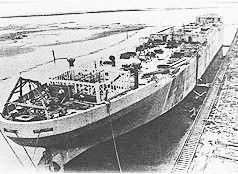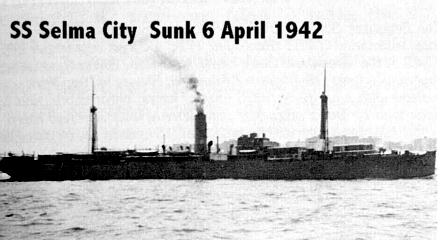|

|
| Confederate Steamship Selma |
Four
Ships Named Selma
By
James Donahue
The first
steamship that bore the name Selma was a Civil War gunship that foundered off the coast of Texas in 1868. Since then, three
other vessels have borne the name. The second was a strange ship with a concrete hull, an experiment tried during World War
I. The last two were casualties of World War II.
The first
Selma was never designed for battle. It was a 320-ton side wheeled coastal steamship originally named Florida, built in 1856
at Mobile, Alabama. When the Civil War broke out, the vessel was seized by the Confederate Government, converted into a warship
and given the name CSS Selma.
From
an early drawing it appears that the conversion was extensive, with much of the superstructure removed, heavy guns mounted
both fore and aft, and possibly even iron sheeting installed.
(This
work was done in 1861 and the history books say that the Monitor and Merrimac, converted to iron in 1862 were the first. The
British, however, launched its first iron ship, the Aaron Manby in 1821 and the British Navy launched its first ironclad warship,
the HMS Warrior in 1860. While the concept of building iron ships was well known by 1861, it was not until the problem of
designing compasses that were not affected by the iron was solved that iron and steel hulled vessels could be used for more
than coastal gunboats.)
The Selma
served in the New Orleans, Mississippi Sound and Mobile Bay area along the Gulf Coast. It successfully engaged in battle with
the U.S. Navy ships Massachusetts and later the U.S.S. Montgomery. During the Battle of Mobile Bay on Aug. 5, 1864, the Selma,
under the command of First Lieutenant Peter U. Murphey, was captured by Union forces. From that time on the ship became the
property of the Union Navy, and bore the name USS Selma. The ship remained active in the New Orleans area until the end of
the war.
The Selma
was decommissioned in 1865 and sold to civilian owners. It was rebuilt as a merchant ship and operated on the high seas until
June 24, 1868, when it foundered off the mouth of the Brazos River near Freeport, Texas.

|
| Concrete Selma |
Selma
number two was an experimental ship with a concrete hull, constructed by F. F. Ley & Company at Mobile, Alabama, in 1919.
World War I was raging and steel was in short supply, so the concept of building ships of concrete was born. A few such ships
were launched at Mobile and in California at about the same time. They sailed successfully, but the hulls proved to be so
brittle they did not last long.
The concrete
SS Selma was an oil tanker. She had a sister ship, the SS Latham. The Selma operated only one year until striking a jetty
at Tampico, Florida, on May 11, 1920. The ship steamed to Galveston, Texas for repair but shipping repair crews had no experience
with concrete ships. Thus the Selma was left in a channel at Pelican Island, Texas, where it has been recognized as a Texas
historical site, a State Archaeological Landmark and the Official Flagship of the Texas “Army.”
(The
Latham also was damaged when it s truck a jetty on its return trip from Tampa, Florida to Philadelphia. It was dismantled
and converted into an oil storage tank at New Orleans.)

|
| Selma City |
There
were two ships afloat during World War II bearing the name Selma. The Selma City was operating under the U.S. flag and the
Selma was a supply ship for the Germans. Both were destroyed.
The SS
Selma City, under command of Captain John Griffin, was steaming from Colombia to Calcutta, carrying a cargo of 150 tons of
case and lube oil plus general cargo when it was bombed and sunk by a Japanese bomber in the Bay of Bengal on April 6, 1942.
The first
bomb missed and exploded off the starboard side of the freighter. A second bomb, however, hit near the engine room, piercing
the deck and exploding over the engine room storeroom. The engine room flooded as a fire quickly spread through the doomed
ship. The plane made a third low-level pass and dropped a third bomb that struck the boiler room.
The crew
of 29 battled the fire until it was obvious that the ship was sinking. Griffin ordered the ship abandoned. The crew launched
four lifeboats and escaped without loss of life.
The German freighter Selma came to a violent end on December 19, 1943, while unloading munitions at
Filipstad, Oslo, Norway. Nobody has ever determined if it was sabotage or an accident that caused the fire that broke out
either on the ship or in the ammunition store. What happened is still remembered as the great Filipstad Explosion that almost
leveled the town.
|

